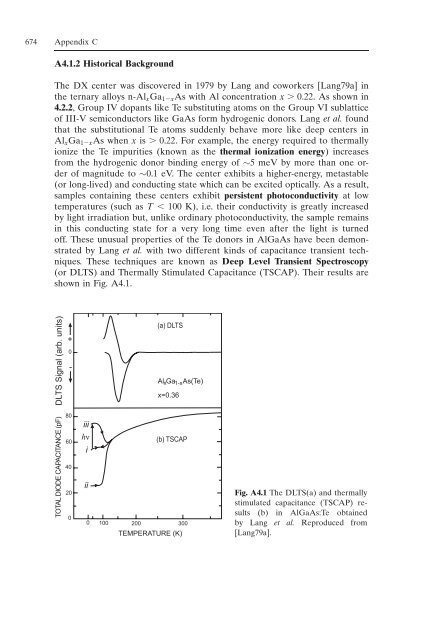10. Appendix
You also want an ePaper? Increase the reach of your titles
YUMPU automatically turns print PDFs into web optimized ePapers that Google loves.
674 <strong>Appendix</strong> C<br />
A4.1.2 Historical Background<br />
The DX center was discovered in 1979 by Lang and coworkers [Lang79a] in<br />
the ternary alloys n-AlxGa1xAs with Al concentration x 0.22. As shown in<br />
4.2.2, Group IV dopants like Te substituting atoms on the Group VI sublattice<br />
of III-V semiconductors like GaAs form hydrogenic donors. Lang et al. found<br />
that the substitutional Te atoms suddenly behave more like deep centers in<br />
AlxGa1xAs when x is 0.22. For example, the energy required to thermally<br />
ionize the Te impurities (known as the thermal ionization energy) increases<br />
from the hydrogenic donor binding energy of ∼5 meV by more than one order<br />
of magnitude to ∼0.1 eV. The center exhibits a higher-energy, metastable<br />
(or long-lived) and conducting state which can be excited optically. As a result,<br />
samples containing these centers exhibit persistent photoconductivity at low<br />
temperatures (such as T 100 K), i.e. their conductivity is greatly increased<br />
by light irradiation but, unlike ordinary photoconductivity, the sample remains<br />
in this conducting state for a very long time even after the light is turned<br />
off. These unusual properties of the Te donors in AlGaAs have been demonstrated<br />
by Lang et al. with two different kinds of capacitance transient techniques.<br />
These techniques are known as Deep Level Transient Spectroscopy<br />
(or DLTS) and Thermally Stimulated Capacitance (TSCAP). Their results are<br />
shown in Fig. A4.1.<br />
DLTS Signal (arb. units)<br />
TOTAL DIODE CAPACITANCE (pF)<br />
+<br />
0<br />
-<br />
80<br />
60<br />
40<br />
20<br />
0<br />
iii<br />
h<br />
i<br />
ii<br />
(a) DLTS<br />
Al xGa 1-xAs(Te)<br />
x=0.36<br />
(b) TSCAP<br />
0 100 200 300<br />
TEMPERATURE (K)<br />
Fig. A4.1 The DLTS(a) and thermally<br />
stimulated capacitance (TSCAP) results<br />
(b) in AlGaAs:Te obtained<br />
by Lang et al. Reproduced from<br />
[Lang79a].










